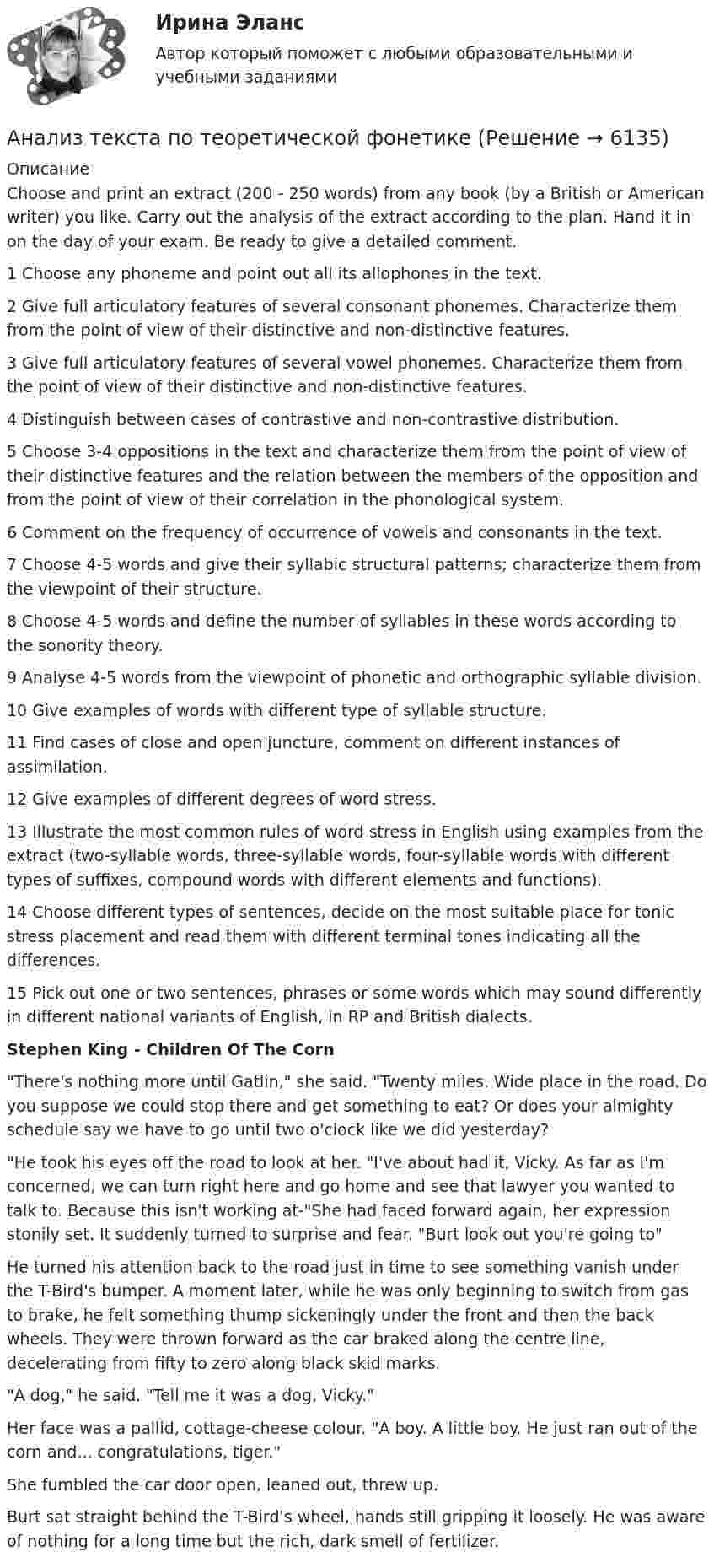
Анализ текста по теоретической фонетике (Решение → 6136)
Choose and print an extract (200 - 250 words) from any book (by a British or American writer) you like. Carry out the analysis of the extract according to the plan. Hand it in on the day of your exam. Be ready to give a detailed comment.
1 Choose any phoneme and point out all its allophones in the text.
2 Give full articulatory features of several consonant phonemes. Characterize them from the point of view of their distinctive and non-distinctive features.
3 Give full articulatory features of several vowel phonemes. Characterize them from the point of view of their distinctive and non-distinctive features.
4 Distinguish between cases of contrastive and non-contrastive distribution.
5 Choose 3-4 oppositions in the text and characterize them from the point of view of their distinctive features and the relation between the members of the opposition and from the point of view of their correlation in the phonological system.
6 Comment on the frequency of occurrence of vowels and consonants in the text.
7 Choose 4-5 words and give their syllabic structural patterns; characterize them from the viewpoint of their structure.
8 Choose 4-5 words and define the number of syllables in these words according to the sonority theory.
9 Analyse 4-5 words from the viewpoint of phonetic and orthographic syllable division.
10 Give examples of words with different type of syllable structure.
11 Find cases of close and open juncture, comment on different instances of assimilation.
12 Give examples of different degrees of word stress.
13 Illustrate the most common rules of word stress in English using examples from the extract (two-syllable words, three-syllable words, four-syllable words with different types of suffixes, compound words with different elements and functions).
14 Choose different types of sentences, decide on the most suitable place for tonic stress placement and read them with different terminal tones indicating all the differences.
15 Pick out one or two sentences, phrases or some words which may sound differently in different national variants of English, in RP and British dialects.
Stephen King - Children Of The Corn
"There's nothing more until Gatlin," she said. "Twenty miles. Wide place in the road. Do you suppose we could stop there and get something to eat? Or does your almighty schedule say we have to go until two o'clock like we did yesterday?
"He took his eyes off the road to look at her. "I've about had it, Vicky. As far as I'm concerned, we can turn right here and go home and see that lawyer you wanted to talk to. Because this isn't working at-"She had faced forward again, her expression stonily set. It suddenly turned to surprise and fear. "Burt look out you're going to"
He turned his attention back to the road just in time to see something vanish under the T-Bird's bumper. A moment later, while he was only beginning to switch from gas to brake, he felt something thump sickeningly under the front and then the back wheels. They were thrown forward as the car braked along the centre line, decelerating from fifty to zero along black skid marks.
"A dog," he said. "Tell me it was a dog, Vicky."
Her face was a pallid, cottage-cheese colour. "A boy. A little boy. He just ran out of the corn and... congratulations, tiger."
She fumbled the car door open, leaned out, threw up.
Burt sat straight behind the T-Bird's wheel, hands still gripping it loosely. He was aware of nothing for a long time but the rich, dark smell of fertilizer.

- Анализ с целью ответить на вопрос: «Что будет, если…?» называется …
- Анализ текста по теоретической фонетике
- Анализ торговой деятельности
- Анализ торговой деятельности 2
- Анализ трудностей реализации стратегии
- Анализ трудового конфликта в организации и методы его разрешения
- Анализ туристско-рекреационных проектов субъекта РФ
- Анализ статьи. Тайм-менеджмент
- Анализ стихотворения В.Ф. Раевского "К СЕЛЬСКОМУ УБЕЖИЩУ"
- Анализ стратегии конкуренции организации
- Анализ стратегического планирования
- Анализ страхового рынка Казахстана
- Анализ структуры и динамики платежных балансов
- Анализ структуры форм реализации ГЧП

